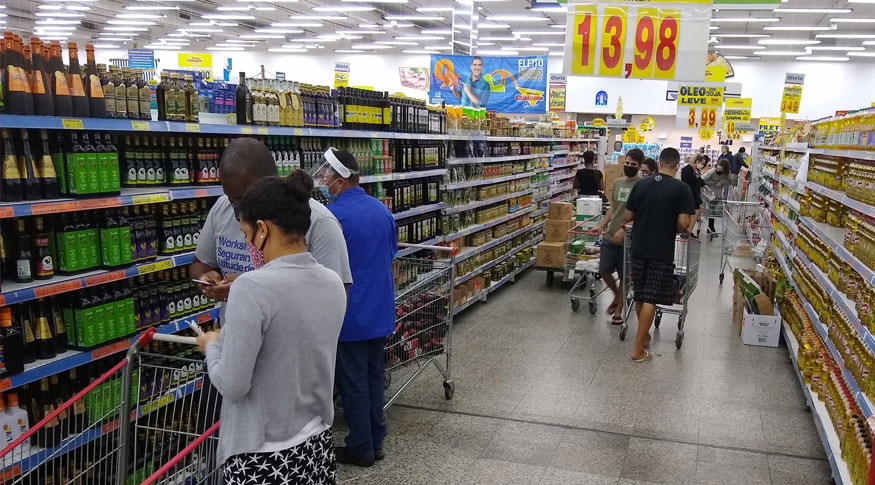IPCA
Inflation accelerates in December and hits 4.52% in 2020, biggest increase since 2016
January 12, 2021 09h00 AM | Last Updated: January 12, 2021 04h28 PM

Inflation closed 2020 at 4.52%, biggest increase since 2016 (6.29%), according to the Extended National Consumer Price Index (IPCA), released today (12) by the IBGE. The December indicator, which was released together with cumulative index in the year, accelerated to 1.35%, the main increase since February 2003 (1.57%) and the highest for a month of December since 2002 (2.10%).
As a result, the annual index was above the middle of the target set by the National Monetary Council, of 4.0%, within the tolerance marging of 1.5 percentage points below (2.5%) or above (5.5%). In 2019, inflation reached 4.31%.
Last year, the hike of 14.09% in food and beverage prices had an impact on the budget of Brazilians. Pedro Kislanov, manager of the IPCA, explains the increase, biggest since 2002 (19.47%), was caused, among other factors, by the demand for those products, the rise of dollar and of the prices of commodities in the international market. That was a global movement of rise of food prices, in a year marked by the Covid-19 pandemic.
Prices of soybean oil (103.79%) and rice (76.01%) had a steep cumulative rise last year. Other relevant items in the family basket also recorded significant increases, for example, long life milk (26.93%), fruits (25.40%), meats (17.97%_ potato (67.27%) and tomato (52.76%).
According to Kislanov, housing (5.25%) also pushed inflation, with an increase led by the rise of electricity (9.14%). Household articles also had an impact, but, due to effects of the dollar currency on the prices of household appliances TV, sound and computer equipment. Together, food and beverages, housing and household articles accounted for almost 84% of the 2020 inflation.
As for Transportation, the second most relevant item to the indication composition, closed the year at 1.03%. “There have been significant decreases, in April and May, due to gasoline prices, and closed the year at a low (-0.19%), in spite of the six consecutive decreses between June and December. Airfares fell by 17.15% cumulative in the year, and helped push the result downward."
The only group to record negative change, says the IPCA manager, was wearing apparel (-1.13%). “Due to social distancing, persons stayed longer at home, and that may have reduced the demand for clothing. Decrease was observed in female appareal (-4.09%) and male apparel (-0.25%) and children apparel (-0.13%), footwear and accessories (-2.14%). The only exception was jewelry and costume jewelry (15.48%), due to the rise of gold.”
In 2020, the rise of prices was widespread in all the 16 localities surveyed by the IBGE. The municipality of Campo Grande (6.85%) recorded the biggest change in the year, due to meats and gasoline. Then came Rio Branco (6.12%), Fortaleza (5.74%), São Luís (5.71%), Recife (5.66%), Vitória (5.15%), Belo Horizonte (4.99%) and Belém (4.63%), all of them above the national average (4.52%).
The lowest index was that of Brasília (3.40%), influenced by the fall of air fare prices (-20.01%), app transportation (-18.71%), furniture items (-7,.2%) and lodging (-6.26%).
Inflation in December is highest since 2003
In December, inflation accelerated to 1.35%, above that of November (0.89%). That is the highest monthly change since February 2003, when the indicator reached 1.57%, and the highest index for a month of December since 2002 (2.10%). In December 2019, the change had reached 1.15%.
Pedro Kislanov observed that, in the month, all the groups surveyed recorded decrease, but the highlight was h ousing (2.88%), due to the rise of electricity (9.34%). “In December, the red flag - level 2 went into effect in the country with an extra charge of R$ 6.243 per every 100 Kw-hour consumed. Also, there was price adjustment in Rio Branco and Porto Alegre."
The second biggest contribution came from food and beverages (1.74%), despite deceleration against the previous month (2.54%). Fall of tomato prices (-13.46%) and less significant rises of meats (3.58%), rice (3.84%) and soybean (4.99%). On the other hand, fruits rose from 2.20% to 6.73%.
Another highlight was transportation (1.36%), with a change close to that in November (1.33%). Other figures ranged between 0.39% for communication and 1.76% for household articles.
Among the areas surveyed, the highest inflation in December was registered in the municipality of São Luís (2.18%), pushed by the hike of 11.30% of meat prices. The lowest result result was that of Aracaju (0.91%), as a result of fall of tuition of regular courses (-0.78%) and in the prices of food products, such as cheese (-6.33%) and tomato (-6.04%).
INPC surpasses IPCA
The IBGE also showed that the National Consumer Price INdex (INPC), which measures inflation among households with lower income, closed 2020 at a high of 5.45%, above the 4.48% of 2019. In December, the INPC accelerated to 1.46%, against the hike of 0.95% registered in November. That was the highest result for a month of December since 2002, when the index was 2.70%. In December 2019, the rate was 1.22%.
Pedro Kislanov points out that INPC surpassed IPCA, both in terms of cumulative figures in the year and of the monthly comparison. “That is due, to a great extenté explicado, em grande medida, pelo peso de aliment, by the weight of food and beverages in the household basket of items, which is bigger in the case of INPC. Housing also has greater relevance, due to electricity”.
INPC has been calculated by the IBGE since 1979. It refers to households with monthly income from 1 to 5 minimum wages, with a salaried head of the household, and encompasses ten metropolitan areas in Brazil, besides the municipalities of Goiânia, Campo Grande, Rio Branco, São Luís, Aracaju and Brasília. IPCA deals with households with an income of up to 40 minimum wages, whatever the source.



















